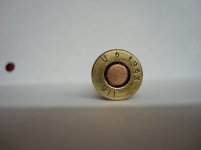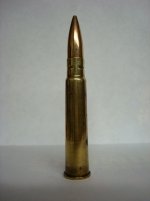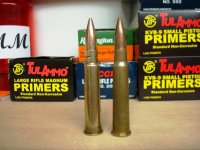Hello, I am not a cartridge collector other than a few that have been given to me or something I have a firearm for. My father gave me a shoe box full of old cases and loaded ammo most of it was .30 carbine 30-30 30-06 and so on. I found a loaded round that I though to be 303 brit. I put it on the shelf with my verry small colection next to the 303 brit cartridge that I had, after looking at them side by side they were just a little different, The cartridge has a head stamp that reads, U, a dimond shape, 1943, VII. The OAL is 77.02mm, bullet diameter is 7.92mm, case OAL is 56.04, Rim diameter is 13.32, now what got me was that the primer size it is realy big, diameter is 6.42 it looks to be a copper cup. Thanks for any information that you could give me I would just like to be able to label it and know what I have. Thanks
You are using an out of date browser. It may not display this or other websites correctly.
You should upgrade or use an alternative browser.
You should upgrade or use an alternative browser.
Cartridige ID need help
- Thread starter NRFJR
- Start date
Tidewater_Kid
New member
Looks like it's South African surplus .303.
Kimberley Branch Mint, Kimberley, Republic of South Africa
http://www.dave-cushman.net/shot/303headstamps.html
TK
Kimberley Branch Mint, Kimberley, Republic of South Africa
http://www.dave-cushman.net/shot/303headstamps.html
TK
Mike Irwin
Staff
Tidewater is correct, it's WW II-era .303 ball ammo made to Mk VII specifications, and is loaded with cordite.
With a crimp that heavy, and that shape shoulder, it makes me think it was loaded primarily for use in the Bren gun.
With a crimp that heavy, and that shape shoulder, it makes me think it was loaded primarily for use in the Bren gun.
The stake crimp is specified on .303 British military ammo (the other case here is commercial ammo). There is some shoulder variation in .303, not important because the case is supported (headspaced, if you will) on the rim and the shoulder just hangs in there in the chamber.
In the early days of "small" caliber ammunition, the neck allowed the use of a large case with a heavy powder charge while firing a bullet of smaller diameter and lighter weight for higher velocity, but the cases were still rimmed. Later, Mauser figured out that if the resulting case shoulder was made uniform and the chamber made to conform, the case could be supported on the shoulder and the rim could be done away with, making feeding easier.
There is a current myth that the .303 is supposed to be supported (headspace) on the case shoulder and that if the case does not fit the chamber perfectly as well as stop on the rim, some kind of disaster will occur. Not true; the chamber can be made with very generous space with no effect at all except for problems resizing cases for reloading, something that did not concern the British army one bit.
Jim
In the early days of "small" caliber ammunition, the neck allowed the use of a large case with a heavy powder charge while firing a bullet of smaller diameter and lighter weight for higher velocity, but the cases were still rimmed. Later, Mauser figured out that if the resulting case shoulder was made uniform and the chamber made to conform, the case could be supported on the shoulder and the rim could be done away with, making feeding easier.
There is a current myth that the .303 is supposed to be supported (headspace) on the case shoulder and that if the case does not fit the chamber perfectly as well as stop on the rim, some kind of disaster will occur. Not true; the chamber can be made with very generous space with no effect at all except for problems resizing cases for reloading, something that did not concern the British army one bit.
Jim
tahunua001
New member
I am going to go out on a limb and say it's a 303 brit that somebody necked up to 8mm.
Mike Irwin
Staff
"The stake crimp is specified on .303 British military ammo..."
That's more than a standard 3-stab stake crimp....
Jean Huon's book also shows examples that appear to have a rather heavy neck crimp instead of a stake crimp.
Ah. Here we go.
Fourth picture down on this page shows a number of WW II era British-made .303 cartridges with a heavy neck crimp.
http://www.conjay.com/Ammunition for Armor Testing WW2 303.htm
Those photos are also a pretty good indication of what kind of variations you'd see in the case neck.
That's more than a standard 3-stab stake crimp....
Jean Huon's book also shows examples that appear to have a rather heavy neck crimp instead of a stake crimp.
Ah. Here we go.
Fourth picture down on this page shows a number of WW II era British-made .303 cartridges with a heavy neck crimp.
http://www.conjay.com/Ammunition for Armor Testing WW2 303.htm
Those photos are also a pretty good indication of what kind of variations you'd see in the case neck.
The stab crimp varied from lines to three round punch marks, and during and after WWII they were sometimes omitted entirely. That may well have been based on the type of bullet used. But the 1929 British Text Book of Small Arms is quite clear in saying that "The bullet is secured into the case by three indents made in the case, the metal of the case being pressed into the cannelure."
Since that was before adoption of the BREN gun, it is reasonable to suppose the process might have arisen out of the cartridge handling by the British Vickers/Maxim gun in WWI. There is no mention of this being special, or limited to machinegun ammunition, nor indeed is there any indication of any separate manufacturing procedures for machinegun ammunition; presumably, any .303 ammunition would be safe and correct for any weapon of that caliber.
Jim
Since that was before adoption of the BREN gun, it is reasonable to suppose the process might have arisen out of the cartridge handling by the British Vickers/Maxim gun in WWI. There is no mention of this being special, or limited to machinegun ammunition, nor indeed is there any indication of any separate manufacturing procedures for machinegun ammunition; presumably, any .303 ammunition would be safe and correct for any weapon of that caliber.
Jim
Last edited:
Mike Irwin
Staff
I know what the Ordnance Ministry called for.
I also know what British arsenals produced at the same time.
At some point in time the evidence is clear that some British manufacturers began using a rather stout neck crimp in place of the mid-neck staking.
Back to the South African ammo, though...
That is, by FAR, the heaviest and most extensive crimping I've ever seen on any .303 cartridge. It's almost excessive, and appears that the only way it could have been applied would be to have been rolled into the neck.
I can't see any possible advantage to using such a crimp unless it was to solve a bullet retention issue.
I also know what British arsenals produced at the same time.
At some point in time the evidence is clear that some British manufacturers began using a rather stout neck crimp in place of the mid-neck staking.
Back to the South African ammo, though...
That is, by FAR, the heaviest and most extensive crimping I've ever seen on any .303 cartridge. It's almost excessive, and appears that the only way it could have been applied would be to have been rolled into the neck.
I can't see any possible advantage to using such a crimp unless it was to solve a bullet retention issue.
Last edited:
mapsjanhere
New member
Mauser figured out that if the resulting case shoulder was made uniform and the chamber made to conform, the case could be supported on the shoulder and the rim could be done away with
The M/88 cartridge - while now known as 8mm Mauser in the US - was NOT a Mauser design but developed as part of the Commission rifle process. The US name was derived of the 7x57 Mauser (which was a Mauser product developed for the 1893 Spanish Mauser) due to the similarity to the German 8x57 civilian description, but it got the parent/child relation wrong.
Hi, mapsjanhere,
The idea of the rimless case seems to have been "in the air" in the 1886-1888 era. You are correct that the 8x57 itself was developed by the GPK and I was wrong in attributing it to Mauser.
But the original idea for a rimless case supported on the shoulder seems to have come, not from Germany at all, but from Col. Eduard Rubin, of the Swiss Army, who came up with the idea c. 1886.
Jim
The idea of the rimless case seems to have been "in the air" in the 1886-1888 era. You are correct that the 8x57 itself was developed by the GPK and I was wrong in attributing it to Mauser.
But the original idea for a rimless case supported on the shoulder seems to have come, not from Germany at all, but from Col. Eduard Rubin, of the Swiss Army, who came up with the idea c. 1886.
Jim
mapsjanhere
New member
I agree, and I would have been surprised if the GPK did actually come up with something original.
The type of crimp on British & Empire .303s has varied considerably over the years with time and contractor. There have been a number of other small changes, some of which don't seem to have been implemented in overseas establishments for some years.
Neither of these looks unusual. Looks like one has been heavily polished in the past - what with? (ammonia-based polish?)
South African stuff of this vintage has been reasonably common in recent years and much of it suffers from season-cracking in the necks, to the point where bullets can be rotated or just pulled out.
Neither of these looks unusual. Looks like one has been heavily polished in the past - what with? (ammonia-based polish?)
South African stuff of this vintage has been reasonably common in recent years and much of it suffers from season-cracking in the necks, to the point where bullets can be rotated or just pulled out.
Mike Irwin
Staff
While the 1888 Commission Rifle was not a Mauser product, I think there is a very strong likelihood that the cartridge itself was developed by Mauser.
At the time Mauserwerk was probably the most active and significant cartridge development entity on the planet.
Based on other development work going on at Mauser at the time, such as with the rifle that would become the Belgian 1889 Mauser, it would appear that Mauserwerk was working with the concept of rimless cartridges at least as early as 1886, possibly even earlier.
It's also possible that the concept sprang up elsewhere in Europe, perhaps at the hands of Col. Rubin's work with what would become the 7.5x55 Swiss.
Or, it's also possible that, with the development of smokeless powder finally solving the chamber fouling problem, that it was one of those ideas whose time had come and it sprang up independently in several places all at once.
But I put my money on Mauserwerk.
At the time Mauserwerk was probably the most active and significant cartridge development entity on the planet.
Based on other development work going on at Mauser at the time, such as with the rifle that would become the Belgian 1889 Mauser, it would appear that Mauserwerk was working with the concept of rimless cartridges at least as early as 1886, possibly even earlier.
It's also possible that the concept sprang up elsewhere in Europe, perhaps at the hands of Col. Rubin's work with what would become the 7.5x55 Swiss.
Or, it's also possible that, with the development of smokeless powder finally solving the chamber fouling problem, that it was one of those ideas whose time had come and it sprang up independently in several places all at once.
But I put my money on Mauserwerk.



